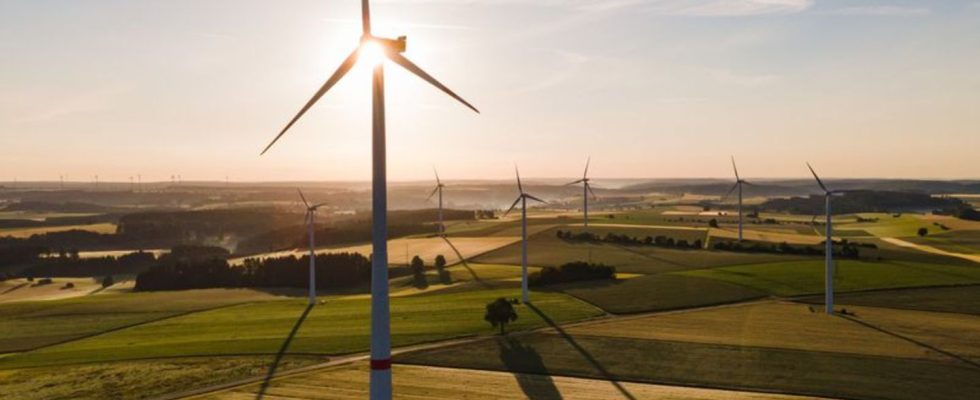The federal government wants to completely renew its climate protection rules. Within the traffic light coalition, one party in particular is satisfied with the plans.
The reform of the climate protection law, which has been heavily criticized by environmentalists, has passed the federal cabinet. The ministers accepted the draft by climate protection minister Robert Habeck (Greens) on Wednesday in Berlin. The traffic light parties SPD, Greens and FDP had already agreed on the reform in the coalition agreement. Above all, it is a concern of the FDP, which the Greens have accepted with little enthusiasm.
What should change
Compliance with the climate targets should no longer be checked retrospectively according to various sectors such as transport, industry or agriculture, but should be forward-looking, multi-year and cross-sectoral. In the future, the federal government as a whole should decide in which sector and with which measures the permissible total amount of CO2 is to be achieved by 2030 – but only if the target is missed two years in a row.
The German climate goals
By 2030, Germany wants to emit 65 percent fewer greenhouse gases than in 1990. According to the Federal Environment Agency, the reduction is currently around 41 percent. According to the goal it has set itself, Germany wants to be climate-neutral by 2045, i.e. not emitting more greenhouse gases than can be bound again.
dilution or not?
The balance of environmental organizations is devastating. They complain that the law has been weakened because, on the one hand, responsibilities would be diluted and, on the other hand, the federal government only has to make adjustments if targets have been missed two years in a row.
The political director of the Climate Alliance Germany, Stefanie Langkamp, criticized: “By canceling the binding sector targets, the FDP is buying its transport minister free from making his contribution to climate protection – at the expense of future generations and all those who are already suffering from the climate crisis Suffer.”
The deputy federal chairman of the CDU and spokesman for the Union faction for climate protection and energy, Andreas Jung (CDU), complained: “The immediate obligation to make adjustments if targets are missed is the heart of reliable climate protection. The traffic light of the climate protection law is now tearing this heart out of the chest.”
The leader of the Greens in the Committee on Climate Protection and Energy, Lisa Badum, was not satisfied. But at least the reform makes it clear “those who don’t row for the common boat and save too little CO2,” she explained. “No ministry can rely on others to fill its own gap.”
Minister Habeck argues that the previous law only looked good on paper. “No sow has adhered to it,” he said last week. Like Badum, he sees a plus in the fact that the government must now keep a closer eye on whether it is on course for its 2030 climate goals and not just following up on the failures of the previous year.
FDP parliamentary group leader Christoph Meyer praised the reform: “Ineffective climate actionism in the form of emergency programs has finally come to an end.” He highlighted the importance of European emissions trading, which allows companies with rights to emit greenhouse gases to trade as needed.
Transport Minister Volker Wissing (FDP) said: “Climate protection is again becoming a task for society as a whole. But we will not be any less ambitious in climate protection in the transport sector.” His range missed the target last time.
SPD faction deputy Matthias Miersch emphasized that the climate goals remained unchanged. “We’re just changing how the goals can be achieved.”
What the climate program envisages
In addition to the revision of the climate protection law, the cabinet has also decided on a package of measures for more climate protection. The program envisages numerous measures, including many that are already known or planned, such as a conversion of the truck toll with a surcharge for CO2 emissions, the expansion of renewable energies or support for the construction of cycle paths.
The climate gap
The program aims to help narrow the gap between climate targets and reality. According to the new projection of the Ministry of Climate Protection, around 200 million tons of climate-damaging greenhouse gases will remain by 2030, which still have to be saved. Habeck sees this as great progress compared to the previous government.
Greenpeace, on the other hand, considers this unacceptable and the federal government must present measures to close the gap. “With such a weak package of measures, the federal government is violating the currently applicable and the new draft of the climate protection law.” The managing director of the Bund für Umwelt und Naturschutz Deutschland (BUND), Antje von Broock, demanded: “Before the end of this legislature, we need certainty about how we can achieve our climate goals.”
What happens next
After the decision in the cabinet, it is the turn of the Bundestag. This must ensure that the law remains effective, warned Heike Vesper from the WWF. “If there is no rescue, the only way to go may be to go to court.” SPD representative Miersch assured: “There will be no softening of the climate goals with the SPD parliamentary group.”
Where the world stands on climate protection
After the Paris Climate Agreement of 2015, the world community wants to limit the increase in global temperatures to 1.5 degrees compared to the pre-industrial period – meaning the period from 1850 to 1900. Scientists believe that this goal can hardly be reached. Between 2011 and 2020, temperatures on Earth were already around 1.1 degrees higher.
According to the Intergovernmental Panel on Climate Change, the 1.5 degrees actually targeted for the end of the century could already be exceeded in the 2030s if the emission of climate-damaging greenhouse gases is not immediately and radically reduced. Models even suggested that by the end of the 21st century warming could reach 2.8 degrees. The consequences include floods, droughts, food crises and water shortages.

